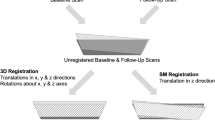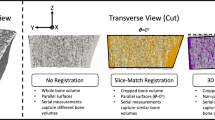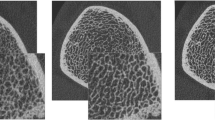Abstract
HR-pQCT enables in vivo multi-parametric assessments of bone microstructure in the distal radius and distal tibia. Conventional HR-pQCT image analysis approaches summarize bone parameters into global scalars, discarding relevant spatial information. In this work, we demonstrate the feasibility and reliability of statistical parametric mapping (SPM) techniques for HR-pQCT studies, which enable population-based local comparisons of bone properties. We present voxel-based morphometry (VBM) to assess trabecular and cortical bone voxel-based features, and a surface-based framework to assess cortical bone features both in cross-sectional and longitudinal studies. In addition, we present tensor-based morphometry (TBM) to assess trabecular and cortical bone structural changes. The SPM techniques were evaluated based on scan-rescan HR-pQCT acquisitions with repositioning of the distal radius and distal tibia of 30 subjects. For VBM and surface-based SPM purposes, all scans were spatially normalized to common radial and tibial templates, while for TBM purposes, rescans (follow-up) were spatially normalized to their corresponding scans (baseline). VBM was evaluated based on maps of local bone volume fraction (BV/TV), homogenized volumetric bone mineral density (vBMD), and homogenized strain energy density (SED) derived from micro-finite element analysis; while the cortical bone framework was evaluated based on surface maps of cortical bone thickness, vBMD, and SED. Voxel-wise and vertex-wise comparisons of bone features were done between the groups of baseline and follow-up scans. TBM was evaluated based on mean square errors of determinants of Jacobians at baseline bone voxels. In both anatomical sites, voxel- and vertex-wise uni- and multi-parametric comparisons yielded non-significant differences, and TBM showed no artefactual bone loss or apposition. The presented SPM techniques demonstrated robust specificity thus warranting their application in future clinical HR-pQCT studies.








Similar content being viewed by others
Abbreviations
- HR-pQCT:
-
High-resolution peripheral quantitative computed tomography
- SPM:
-
Statistical parametric mapping
- VBM:
-
Voxel-based morphometry
- TBM:
-
Tensor-based morphometry
- BV/TV:
-
Bone volume fraction
- vBMD:
-
Volumetric bone mineral density
- SED:
-
Strain energy density
- µFEA:
-
Micro-finite element analysis
- SIT:
-
Streamline integral thickness
- DetJ:
-
Determinant of Jacobian
- MDT:
-
Minimum deformation template
References
Ashburner, J., and K. J. Friston. Voxel-based morphometry—the methods. Neuroimage 11(6 Pt 1):805–821, 2000.
Burghardt, A. J., H. R. Buie, A. Laib, S. Majumdar, and S. K. Boyd. Reproducibility of direct quantitative measures of cortical bone microarchitecture of the distal radius and tibia by HR-pQCT. Bone 47(3):519–528, 2010.
Burghardt, A. J., G. J. Kazakia, S. Ramachandran, T. M. Link, and S. Majumdar. Age- and gender-related differences in the geometric properties and biomechanical significance of intracortical porosity in the distal radius and tibia. J. Bone Miner. Res. 25(5):983–993, 2010.
Cachier, P., and X. Pennec. 3D non-rigid registration by gradient descent on a Gaussian-windowed similarity measure using convolutions. IEEE Workshop on Mathematical Methods in Biomedical Image Analysis, Proceedings, pp. 182–189, 2000.
Caldairou, B., F. Rousseau, N. Passat, P. Habas, C. Studholme, and C. Heinrich. A non-local fuzzy segmentation method: application to brain MRI. Comput. Anal. Images Patterns Proc. 5702:606–613, 2009.
Carballido-Gamio, J., and S. Majumdar. Atlas-based knee cartilage assessment. Magn. Reson. Med. 66(2):574–583, 2011.
Carballido-Gamio, J., J. S. Bauer, R. Stahl, K. Y. Lee, S. Krause, T. M. Link, and S. Majumdar. Inter-subject comparison of MRI knee cartilage thickness. Med. Image Anal. 12(2):120–135, 2008.
Carballido-Gamio, J., T. M. Link, and S. Majumdar. New techniques for cartilage magnetic resonance imaging relaxation time analysis: texture analysis of flattened cartilage and localized intra- and inter-subject comparisons. Magn. Reson. Med. 59(6):1472–1477, 2008.
Carballido-Gamio, J., R. Harnish, I. Saeed, T. Streeper, S. Sigurdsson, S. Amin, E. J. Atkinson, T. M. Therneau, K. Siggeirsdottir, X. Cheng, L. J. Melton, 3rd, J. Keyak, V. Gudnason, S. Khosla, T. B. Harris, and T. F. Lang. Proximal femoral density distribution and structure in relation to age and hip fracture risk in women. J. Bone Miner. Res. 28(3):537–546, 2013.
Carballido-Gamio, J., R. Harnish, I. Saeed, T. Streeper, S. Sigurdsson, S. Amin, E. J. Atkinson, T. M. Therneau, K. Siggeirsdottir, X. Cheng, L. J. Melton, 3rd, J. H. Keyak, V. Gudnason, S. Khosla, T. B. Harris, and T. F. Lang. Structural patterns of the proximal femur in relation to age and hip fracture risk in women. Bone 57(1):290–299, 2013.
Carballido-Gamio, J., S. Bonaretti, I. Saeed, R. Harnish, R. Recker, A. J. Burghardt, J. H. Keyak, T. Harris, S. Khosla, and T. Lang. Automatic multi-parametric quantification of the proximal femur with quantitative computed tomography. Quant. Imaging Med. Surg. 5(4):552–568, 2015.
Cheung, A. M., J. D. Adachi, D. A. Hanley, D. L. Kendler, K. S. Davison, R. Josse, J. P. Brown, L. G. Ste-Marie, R. Kremer, M. C. Erlandson, L. Dian, A. J. Burghardt, and S. K. Boyd. High-resolution peripheral quantitative computed tomography for the assessment of bone strength and structure: a review by the Canadian Bone Strength Working Group. Curr. Osteoporos. Rep. 11(2):136–146, 2013.
Davatzikos, C., M. Vaillant, S. M. Resnick, J. L. Prince, S. Letovsky, and R. N. Bryan. A computerized approach for morphological analysis of the corpus callosum. J. Comput. Assist. Tomogr. 20(1):88–97, 1996.
Friston, K. J., C. D. Frith, P. F. Liddle, R. J. Dolan, A. A. Lammertsma, and R. S. Frackowiak. The relationship between global and local changes in PET scans. J. Cereb. Blood Flow Metab. 10(4):458–466, 1990.
Genovese, C. R., N. A. Lazar, and T. Nichols. Thresholding of statistical maps in functional neuroimaging using the false discovery rate. Neuroimage 15(4):870–878, 2002.
Griffith, J. F., K. Engelke, and H. K. Genant. Looking beyond bone mineral density: imaging assessment of bone quality. Ann. N. Y. Acad. Sci. 1192:45–56, 2010.
Hazrati Marangalou, J., F. Eckstein, V. Kuhn, K. Ito, M. Cataldi, F. Taddei, and B. van Rietbergen. Locally measured microstructural parameters are better associated with vertebral strength than whole bone density. Osteoporos. Int. 25(4):1285–1296, 2014.
Hazrati Marangalou, J., K. Ito, F. Taddei, and B. van Rietbergen. Inter-individual variability of bone density and morphology distribution in the proximal femur and T12 vertebra. Bone 60:213–220, 2014.
Hua, X., A. D. Leow, J. G. Levitt, R. Caplan, P. M. Thompson, and A. W. Toga. Detecting brain growth patterns in normal children using tensor-based morphometry. Hum. Brain Mapp. 30(1):209–219, 2009.
Jones, S. E., B. R. Buchbinder, and I. Aharon. Three-dimensional mapping of cortical thickness using Laplace’s equation. Hum. Brain Mapp. 11(1):12–32, 2000.
Kazakia, G. J., J. A. Nirody, G. Bernstein, M. Sode, A. J. Burghardt, and S. Majumdar. Age- and gender-related differences in cortical geometry and microstructure: Improved sensitivity by regional analysis. Bone 52(2):623–631, 2013.
Krebs, A., C. Graeff, I. Frieling, B. Kurz, W. Timm, K. Engelke, and C. C. Gluer. High resolution computed tomography of the vertebrae yields accurate information on trabecular distances if processed by 3D fuzzy segmentation approaches. Bone 44(1):145–152, 2009.
Laib, A., H. J. Hauselmann, and P. Ruegsegger. In vivo high resolution 3D-QCT of the human forearm. Technol. Health Care 6(5–6):329–337, 1998.
Lang, T. F., I. H. Saeed, T. Streeper, J. Carballido-Gamio, R. J. Harnish, L. A. Frassetto, S. M. Lee, J. D. Sibonga, J. H. Keyak, B. A. Spiering, C. M. Grodsinsky, J. J. Bloomberg, and P. R. Cavanagh. Spatial heterogeneity in the response of the proximal femur to two lower-body resistance exercise regimens. J. Bone Miner. Res. 29(6):1337–1345, 2014.
Li, W., I. Kezele, D. L. Collins, A. Zijdenbos, J. Keyak, J. Kornak, A. Koyama, I. Saeed, A. Leblanc, T. Harris, Y. Lu, and T. Lang. Voxel-based modeling and quantification of the proximal femur using inter-subject registration of quantitative CT images. Bone 41(5):888–895, 2007.
Li, W., J. Kornak, T. Harris, J. Keyak, C. Li, Y. Lu, X. Cheng, and T. Lang. Identify fracture-critical regions inside the proximal femur using statistical parametric mapping. Bone 44(4):596–602, 2009.
Manske, S. L., Y. Zhu, C. Sandino, and S. K. Boyd. Human trabecular bone microarchitecture can be assessed independently of density with second generation HR-pQCT. Bone 79:213–221, 2015.
Nirody, J. A., K. P. Cheng, R. M. Parrish, A. J. Burghardt, S. Majumdar, T. M. Link, and G. J. Kazakia. Spatial distribution of intracortical porosity varies across age and sex. Bone 75:88–95, 2015.
Nishiyama, K. K., and E. Shane. Clinical imaging of bone microarchitecture with HR-pQCT. Curr. Osteoporos. Rep. 11(2):147–155, 2013.
Pialat, J. B., A. J. Burghardt, M. Sode, T. M. Link, and S. Majumdar. Visual grading of motion induced image degradation in high resolution peripheral computed tomography: impact of image quality on measures of bone density and micro-architecture. Bone 50(1):111–118, 2012.
Poole, K. E., G. M. Treece, G. R. Ridgway, P. M. Mayhew, J. Borggrefe, and A. H. Gee. Targeted regeneration of bone in the osteoporotic human femur. PLoS ONE 6(1):e16190, 2011.
Poole, K. E., G. M. Treece, P. M. Mayhew, J. Vaculik, P. Dungl, M. Horak, J. J. Stepan, and A. H. Gee. Cortical thickness mapping to identify focal osteoporosis in patients with hip fracture. PLoS ONE 7(6):e38466, 2012.
Poole, K. E., G. M. Treece, A. H. Gee, J. P. Brown, M. R. McClung, A. Wang, and C. Libanati. Denosumab rapidly increases cortical bone in key locations of the femur: a 3D bone mapping study in women with osteoporosis. J. Bone Miner. Res. 30:46–54, 2014.
Rajagopalan, V., J. Scott, P. A. Habas, K. Kim, F. Rousseau, O. A. Glenn, A. J. Barkovich, and C. Studholme. Mapping directionality specific volume changes using tensor based morphometry: an application to the study of gyrogenesis and lateralization of the human fetal brain. Neuroimage 63(2):947–958, 2012.
Robbins, S., A. C. Evans, D. L. Collins, and S. Whitesides. Tuning and comparing spatial normalization methods. Med. Image Anal. 8(3):311–323, 2004.
Saha, P. K., Y. Liu, C. Chen, D. Jin, E. M. Letuchy, Z. Xu, R. E. Amelon, T. L. Burns, J. C. Torner, S. M. Levy, and C. A. Calarge. Characterization of trabecular bone plate-rod microarchitecture using multirow detector CT and the tensor scale: Algorithms, validation, and applications to pilot human studies. Med. Phys. 42(9):5410–5425, 2015.
Schwartzman, A., R. F. Dougherty, and J. E. Taylor. Cross-subject comparison of principal diffusion direction maps. Magn. Reson. Med. 53(6):1423–1431, 2005.
Sode, M., A. J. Burghardt, G. J. Kazakia, T. M. Link, and S. Majumdar. Regional variations of gender-specific and age-related differences in trabecular bone structure of the distal radius and tibia. Bone 46(6):1652–1660, 2010.
Thompson, D. W. On Growth and Form (New ed.). Cambridge: Cambridge University Press, 1942.
Thompson, P. M., and L. G. Apostolova. Computational anatomical methods as applied to ageing and dementia. Br. J. Radiol. 80(Spec. No. 2):S78–S91, 2007.
Treece, G. M., and A. H. Gee. Independent measurement of femoral cortical thickness and cortical bone density using clinical CT. Med. Image Anal. 20(1):249–264, 2015.
Treece, G. M., A. H. Gee, P. M. Mayhew, and K. E. Poole. High resolution cortical bone thickness measurement from clinical CT data. Med. Image Anal. 14(3):276–290, 2010.
Treece, G. M., K. E. Poole, and A. H. Gee. Imaging the femoral cortex: thickness, density and mass from clinical CT. Med. Image Anal. 16(5):952–965, 2012.
Treece, G. M., A. H. Gee, C. Tonkin, S. K. Ewing, P. M. Cawthon, D. M. Black, K. E. Poole, and for the Osteoporotic Fractures in Men (MrOS) Study. Predicting hip fracture type with cortical bone mapping (CBM) in the osteoporotic fractures in men (MrOS) study. J. Bone Miner. Res. 30(11):2067–2077, 2015.
Vasilic, B., C. S. Rajapakse, and F. W. Wehrli. Classification of trabeculae into three-dimensional rodlike and platelike structures via local inertial anisotropy. Med. Phys. 36(7):3280–3291, 2009.
Vercauteren, T., X. Pennec, A. Perchant, and N. Ayache. Non-parametric diffeomorphic image registration with the demons algorithm. Med. Image Comput. Assist. Interv. 10(Pt 2):319–326, 2007.
Whitmarsh, T., G. M. Treece, A. H. Gee, and K. E. Poole. mapping bone changes at the proximal femoral cortex of postmenopausal women in response to alendronate and teriparatide alone, combined or sequentially. J. Bone Miner. Res. 30(7):1309–1318, 2015.
Zebaze, R., A. Ghasem-Zadeh, A. Mbala, and E. Seeman. A new method of segmentation of compact-appearing, transitional and trabecular compartments and quantification of cortical porosity from high resolution peripheral quantitative computed tomographic images. Bone 54(1):8–20, 2013.
Acknowledgments
This work was supported by the NIH/NIAMS under Grants R01AR068456, R01AR060700, R01AR064140 and P30AR066262.
Author information
Authors and Affiliations
Corresponding author
Ethics declarations
Conflicts of Interest
The authors have no relevant conflicts of interest to disclose.
Additional information
Associate Editor Mona Kamal Marei oversaw the review of this article.
Rights and permissions
About this article
Cite this article
Carballido-Gamio, J., Bonaretti, S., Kazakia, G.J. et al. Statistical Parametric Mapping of HR-pQCT Images: A Tool for Population-Based Local Comparisons of Micro-Scale Bone Features. Ann Biomed Eng 45, 949–962 (2017). https://doi.org/10.1007/s10439-016-1754-8
Received:
Accepted:
Published:
Issue Date:
DOI: https://doi.org/10.1007/s10439-016-1754-8




